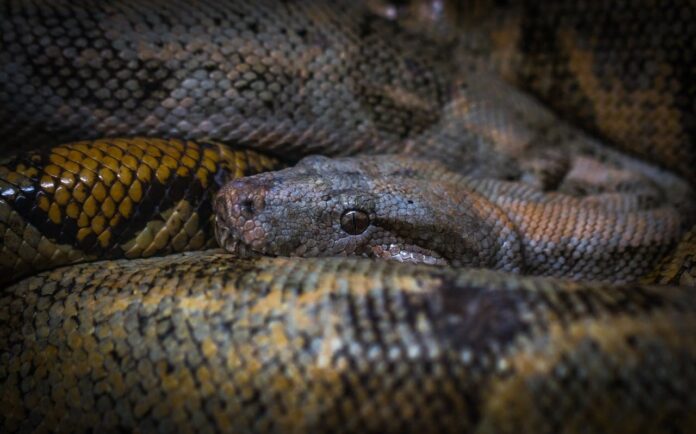Behold anacondas, the semiaquatic stranglers that are ones to be feared. There are 5 living anaconda species today, and these water boas are very dangerous. It is not that they would go out of their way to hunt humans, but encountering one is such a dead wish. Despite being non-venomous, anacondas can easily take anything out with their deadly cuddles. Large and muscly sounds like a dreamy description yet it is better to stay away from. Anacondas prey on both aquatic and terrestrial animals, and we are going to discuss each of them below.
1Bolivian Anaconda
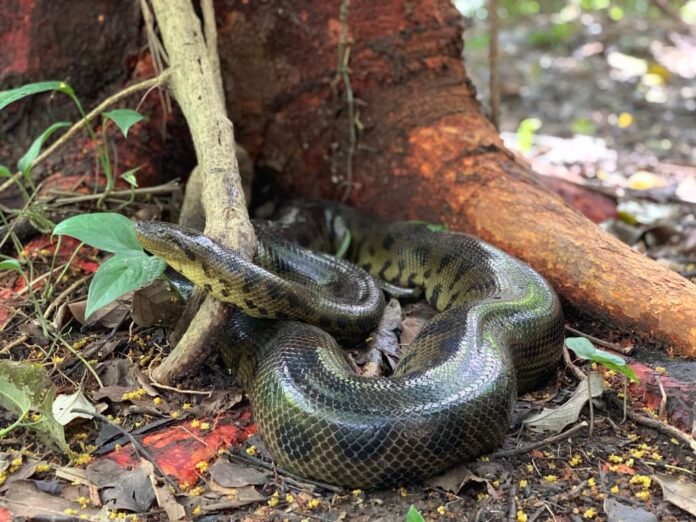
Scientific Name: Eunectes Beniensis
Found in 2002, it is actually a new anaconda species so there is not a lot of information about this one yet. The Bolivian anaconda is a medium-sized boa that can reach a length of 3.3 up to 4.4 meters long. A Bolivian anaconda has a small head with a thick and muscular body, and it has 5 head stripes. Being closely related to the green anaconda and the yellow anaconda, the appearance of the Bolivian anacondas resembles their relatives. It is usually greenish to yellowish-brown in color, and it has black or dark brown splotches all over its bulky body. This huge body that it has is extremely powerful, and it has enough strength to overpower its prey and threats.
This anaconda species is from the northeastern parts of Bolivia; hence the name. Since it is from the Beni region, it is also known as Beni anaconda. Across their ranges, these boas inhabit flood areas, flooded savannas, muddy areas, rainforests, swampy areas, and wetlands. Just like all boas out there, this carnivore is non-venomous, and its diet consists of aquatic animals. Some of the most common meals are caimans, birds, deer, fish, large rodents, peccaries, and river fowls. However, they also take on small livestock like chickens as well should the opportunities arise. They are solitary hunters, and they patiently wait for the prey to come to drink water and then attack them. Bolivian anacondas are not aggressive but they will not hesitate to attack or bite when cornered.
2Dark-Spotted Anaconda
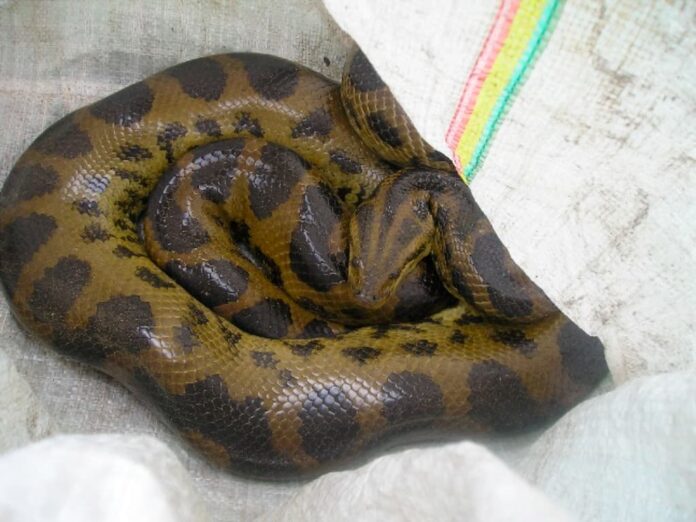
Scientific Name: Eunectes Deschauenseei
The dark-spotted anaconda aka De Schauensee’s anaconda is an anaconda species that reaches a length of 2.3 meters. It has a darker brown body with large black spots just like its cousins. They are native to northeastern South America where they inhabit swampy and seasonally flooded freshwater areas. Since it is highly aquatic, it favors densely-vegetated waters where it can submerge and hide. This boa spends all its life in and around water; therefore, it has a strong ability to dive and swim. When not in water, a dark-spotted anaconda climbs up in trees to sunbathe by hanging from branches above bodies of water. Unfortunately, their savanna habitat is highly threatened by agricultural expansion.
3Green Anaconda
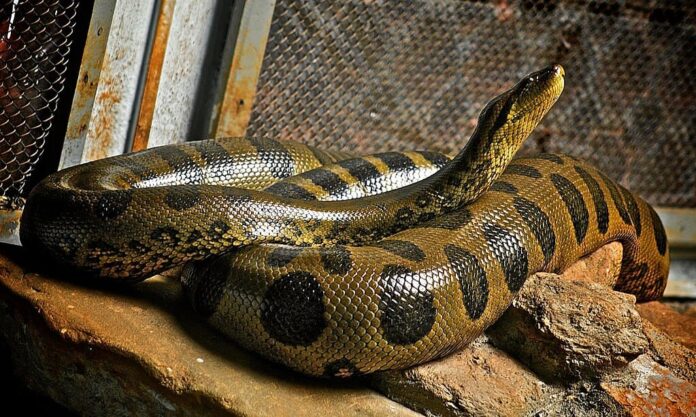
Scientific Name: Eunectes Murinus
Here you are looking at the heaviest snake in the world, the green anaconda aka giant anaconda. In fact, it is the second largest snake in the world, reaching up to 5 meters in some specimens. Not different from a few other anaconda species, this one is also olive green on the background with black blotches. A green anaconda has a narrow head with distinctive orange-yellow stripes on each side. If you look closer, you can see that the eyes and nose are high on the head. This placement is beneficial for the boa to see out of the water while swimming without exposing its body. These boas can float under the water, and they are also fast swimmers as well. When strike, a green anaconda coils around the prey first to suffocate it until it dies. Then, the swallowing begins.
This semiaquatic boa species is found in the Caribbean islands of Trinidad and South America. They live in lagoons, marshes, slow-moving rivers and streams, and swamps in tropical rainforests and seasonally flooded savannas. Being one of the largest snakes also means they take on large prey; hence, the loosely connected jaw bones. These jaw bones splay open at the front which allow the boa to swallow prey that is larger than its head.
Another thing is the windpipe in its mouth that allows it to breathe while swallowing prey. Large meals also take longer to digest, and some can take up to days to complete. And speaking of meals, their common food includes amphibians, birds, fish, and other reptiles. The larger ones though, are caimans, deer, capybaras, deer, iguanas, jaguars, tapirs, wild pigs, and even turtles.
4Northern Green Anaconda
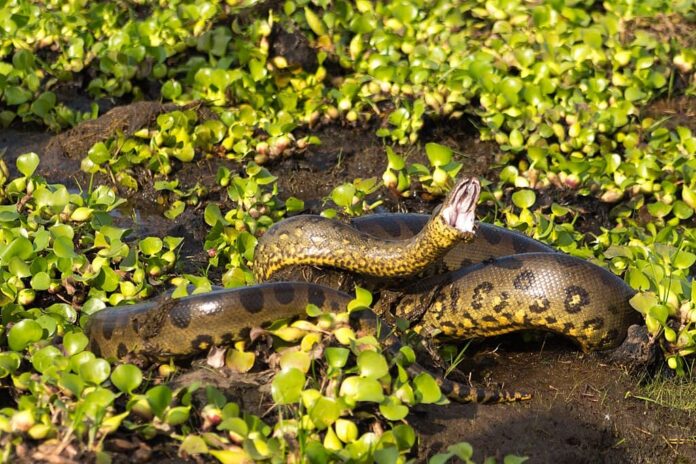
Scientific Name: Eunectes Akayima
Discovered last year in 2024, this boa is the largest anaconda species in the world to date. Heavier and longer than the green anaconda, one of the specimens from this species was 6.3 meters long. A northern green anaconda is olive green in color, and it has dark oval spots along its spine. Along with that, there are yellow-centered spots along its sides and two dark stripes running from its eyes to its jaws. The body of the snake is stocky and muscular, and it has a narrow head with eyes and nostrils on top.
Northern green anacondas are the apex predators of the rivers, swamps, and wetlands across Northern South America. Not different from other anaconda species out there, this one also spends most of its time submerged in shallow waters. They are nocturnal and solitary, and they spend most of their time alone and in the water. When the prey comes nearby to drink water, the anaconda leaps out and takes hold of the prey with its strong jaws. Their usual menu comprises capybaras, caimans, and deer. Unfortunately, their population is not doing well at the moment due to a small range that is also under habitat degradation and fragmentation.
5Yellow Anaconda
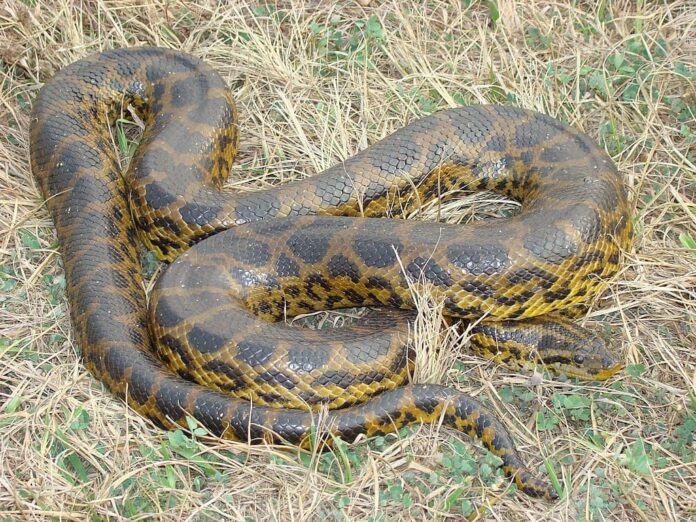
Scientific Name: Eunectes Notaeus
This anaconda species has an average size of 3.7 meters but larger females can be as long as 4.6 meters. Rather brighter than the rest of the family, a yellow anaconda has a combination of golden-tan or greenish-yellow and yellow on the background. At the same time, there is a series of overlapping black or dark brown blotches, spots, and streaks all over. There is also a pattern of yellow and black scales on the underside of the snake’s lower tail. The cool part is each yellow anaconda has its own unique pattern on its underside. Though not attacking humans, yellow anacondas can be aggressive when approached or threatened.
One of the most interesting things about the yellow anacondas is their reproduction. During the breeding season, a female releases pheromones into the air for the males to follow. The courtship usually takes place in the water. However, these anacondas also form breeding balls where multiple males compete for one female. This breeding ball can last for up to a month when the largest male wins and gets to mate. And when the breeding season is over, they all go back to being solitary again.
Endemic to Southern South America, the range of these constrictors is across the Paraguay River and its tributaries. And just like other anacondas out there, they inhabit brush-covered banks of slow-moving rivers and streams, marshes, and swamps. Their regular meals include a number of amphibians, birds, eggs, fish, mammals, and reptiles in the areas. These boas can also take on larger prey like brocket deer, capybaras, and peccaries as well. Despite being one of the apex predators, they sometimes fall prey to caimans, cougars, jaguars, and larger anacondas. People also hunt them for their skin to make belts, purses, and shoes, and for pet trade. Yellow anacondas are now considered Threatened on the IUCN Red List due to poaching.
Related Post: Anaconda Facts

